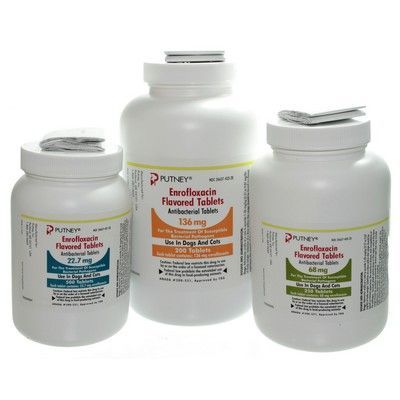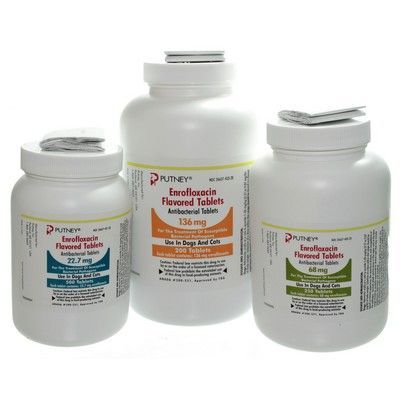Providing Quality & Trust || Clinic Website
Detailed Description
Enrofloxacin Flavored Tablet
(en-roe-flox-a-sin)
- Description: Fluoroquinolone Antibiotic
- Other Names for this Medication: Baytril®
- Common Dosage Forms: Veterinary: 22.7 mg, 68 mg, & 136 mg tablets (flavored); 68 mg tablets (unflavored).
- Antimicrobial Classification: Critically Important
Orally administered enrofloxacin is used to treat animals with certain bacterial infections. The FDA has approved this antibiotic for use in multiple species. The FDA allows veterinarians to prescribe and use products containing this drug in additional species or for other conditions in certain situations. You and your veterinarian can discuss why this drug is the most appropriate choice.
- This drug is best given on an empty stomach and without food, but if your animal vomits or acts sick after getting it, give with food or small treat(no dairy products, antacids or anything containing iron) to see if this helps. If vomiting continues, contact your veterinarian.
- Do not crush film-coated tablets, as the drug is bitter tasting and you may have a harder time getting your animal to take it.
- Do not give at the same time with other drugs or vitamins that contain calcium, iron, or aluminum (including sucralfate), as these can reduce the amount of drug absorbed.
- May cause joint abnormalities if used in young animals, during pregnancy, or while nursing.
- Most common side effects are vomiting, nausea, and diarrhea.
- Do not exceed dosing recommendations in cats, as blindness can result.
Prescriber Highlights:
- Veterinary oral and injectable fluoroquinolone antibiotic effective against a variety of pathogens; not effective against anaerobes. In dogs, oral bioavailability is better and more predictable than with ciprofloxacin.
- When possible, use should be avoided in young, growing animals because of the potential negative impact on cartilage development.
- Caution is advised in patients with hepatic or renal insufficiency or dehydration.
- Higher doses (greater than 5 mg/kg/day) not recommended in cats; may cause blindness
- Adverse effects include GI distress, CNS stimulation, crystalluria, or hypersensitivity; IV administration can be risky in small animals.
- Administration to dogs and cats should be PO, ideally on an empty stomach (unless vomiting occurs).
- Many potential drug interactions
- FDA prohibits extra-label use in food animals. Should not be used in humans (CNS effects).
Uses/Indications:
The oral formulation of enrofloxacin is FDA approved for use in dogs and cats for the management of bacterial infections susceptible to enrofloxacin. Because of the feline dose restriction (5 mg/kg/day) and because better options are usually available for cats, enrofloxacin is generally used in this species to treat only the most susceptible bacterial infections. Enrofloxacin is also FDA approved for use in cattle (not dairy cattle or veal calves) and pigs; extra-label use is prohibited in food animals.
The World Health Organization (WHO) has designated enrofloxacin as a Critically Important, Highest Priority, antimicrobial for human medicine.
What are the side effects ofthis medication?
Side effects that usually are not serious include:
- Vomiting, nausea, reduced appetite.
You don’t have to be overly concerned if you see any of these signs unless they are severe, worsen, or continue to be a problem. Contact your veterinarian if this happens.
Side effects that may be serious orindicate a serious problem:
- Joint(cartilage) effects (trouble walking), especially in young growing animals.
- Central nervous system effects including stimulation or seizures (rare), especially in animals with liver or kidney problems.
- Blindness (cats). Using the drug longer than 30 days or if given at dosages above those labeled could cause blindness in cats.
- Watch for fever, rashes, or trouble breathing as these signs may indicate a drug allergy.
- No appetite or refuses to eat. Complete loss of appetite can sometimes cause liver problems (especially in cats).
If you see any of these signs, contact your veterinarian immediately.
Adverse Effects:
When enrofloxacin is used as labeled, its adverse effect profile is usually limited to GI distress (eg, vomiting, diarrhea, anorexia). In dogs, rare incidences of elevated hepatic enzymes, ataxia, seizures, depression, lethargy, and nervousness have also been reported. Hypersensitivity reactions or crystalluria could potentially occur.
In cats, ocular toxicity has been reported, characterized by mydriasis, retinal degeneration, and blindness. These effects were generally seen at higher dosage ranges and have necessitated a reduction in dose recommendations in cats to a maximum of 5 mg/kg/day. Mydriasis may be an indication of impending or existing retinal changes. Other rare adverse effects seen in cats can include vomiting, anorexia, elevated hepatic enzymes, diarrhea, ataxia, seizures, depression/lethargy, vocalization, and aggression.
Articular cartilage abnormalities have been noted in young, rapidly growing animals (see Contraindications/Precautions/Warnings).
Although enrofloxacin has been implicated in causing antibiotic-associated diarrhea and enterocolitis in horses, because of its poor activity against anaerobes, oral or parenterally administered enrofloxacin appears to carry a low risk for causing antibiotic-associated diarrhea.
Precautions/Warnings:
Enrofloxacin is labeled as contraindicated in patients hypersensitive to it as well as in small- and medium-breed dogs aged 2 to 8 months. Bubble-like changes in articular cartilage have been noted when the drug was given at 2 to 5 times the recommend dosage for 30 days, although clinical signs have only been seen at 5 times the recommended dosage. To avoid cartilage damage, treatment for large- and giant-breed dogs may need to wait until 12 to 18 months of age, respectively. Enrofloxacin at concentrations greater than 1 mg/mL was toxic to equine chondrocytes.
Because ciprofloxacin has occasionally been reported to cause crystalluria in humans, animals should not be allowed to become dehydrated during therapy with either ciprofloxacin or enrofloxacin. Enrofloxacin may cause CNS stimulation and should be used with caution in patients with seizure disorders. Patients with severe renal or hepatic impairment may require dose interval adjustments to prevent drug accumulation. Enrofloxacin is not recommended in cats with impaired renal function because there is an increased risk for retinotoxicity.
Use of the canine injectable products in cats or dogs via other non-FDA–approved parenteral routes (IV, SC) is controversial and may result in significant adverse effects. Parenteral administration in cats at doses greater than 5 mg/kg should not be considered because of reported retinal toxicity (blindness). Because of the high pH (≈11) of the solution, SC administration in any species may cause pain and tissue damage.
Rapid or undiluted IV administration to dogs increases risk for cardiac arrhythmias, hypotension, vomiting, and mast cell degranulation (ie, release of histamine and other inflammatory mediators). Extra-label use of the 22.7 mg/mL (2.27%) injectable solution diluted 1:1 to 1:10 with sodium chloride 0.9% for slow IV administration (over 10-30 minutes) has been described. Injectable enrofloxacin must not be mixed with or come into contact with any IV solution containing magnesium (eg, Normosol®-R, Plasmalyte®-R, -A, or –56); morbidity and mortality secondary to microprecipitants lodging in patient’s lungs have been reported.
Dilution and extra-label use of the large animal product (100 mg/mL; 10%) in small animals via any route is discouraged.
Enrofloxacin should not be used in foals, as they appear to be highly susceptible to the fluoroquinolone’s arthropathic effects. IV administration should not be provided rapidly to horses, as ataxia and other neurologic effects may occur. IM injections are not recommended in horses, as localized tissue reactions can occur. Intrauterine infusion of enrofloxacin is not suitable, as it can cause serious tissue changes (eg, endometrial ulceration, necrosis, fibrosis, inflammation, hemorrhage).
Extra-label use of fluoroquinolones is prohibited in food animals.
Enrofloxacin should not be used in humans; it may cause hallucinations, vivid dreams, and/or headaches.
If you have any other questions about this medication, contact your veterinarian or pharmacist.
Powered by nopCommerce
This site is running in live payment mode. Real payments will be processed.

